Supposedly, it was supposed to stand as long as "faith in man" and "Soviet friendship" will last. The Soviet Union collapsed, we lack friendship with communists, we believe in people less and less, and the Palace? on his 60th birthday, we bring you six most interesting facts about Stalin's "gift".
1. Palace of Culture and Science before the war?
March 1936. Opening of the exhibition "Warsaw of the Future" at the National Museum. Presidents Stefan Starzyński and Ignacy Mościcki bend over the model of the city, on which a miniature building resembling a space rocket is visible. It is confusingly similar to the Palace of Culture and Science, but no one even dreams of it yet. How is that possible?
The cardboard rocket on the model is "Independence Tower" designed by Juliusz Nagórski, the famous co-founder of the Polonia hotel. The soaring building was to be erected at the Washington Roundabout in Saska Kępa, reigning over Warsaw and recalling the power of Poland after regaining independence.
Unfortunately, the implementation of these plans never went beyond the sketches on the drawing board. It is a pity, because perhaps we would have two similar palaces.
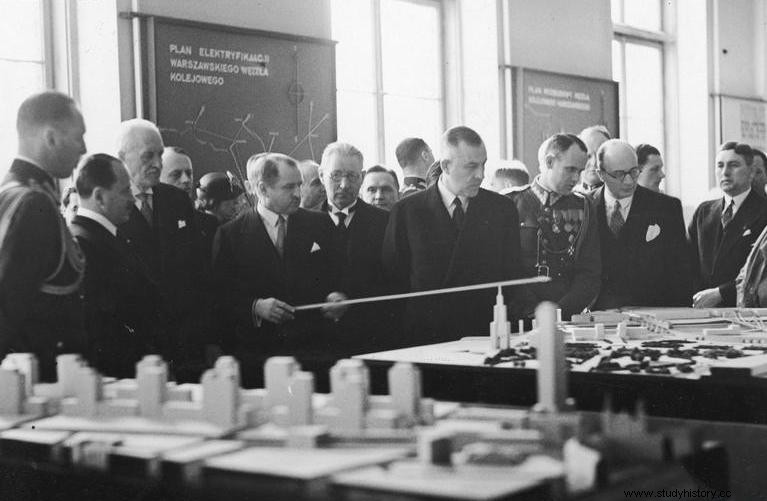
President Stefan Starzyński points to the design of Juliusz Nagórski's building, which was to tower over Warsaw. Any associations? (source:public domain)
2. Krakow inspirations
Stalin's assumption was that the Palace of Culture and Science was to resemble the Moscow Technical University. However, a team of Polish and Soviet architects debated the final shape and height of the building for a long time.
The commander-in-chief Lew Rudniew insisted on giving the building a Polish character So the Russians set out on a sightseeing trip around Poland. The Soviet team visited, among others Kraków, Toruń, Kazimierz on the Vistula, Zamość and Chełmno.
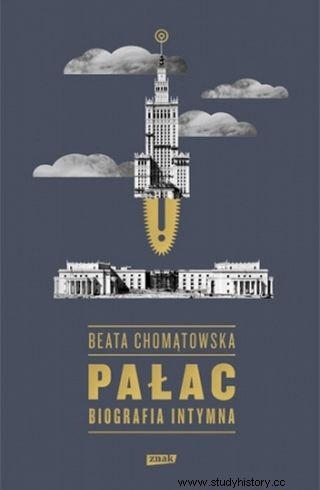
Rudniew himself was enchanted by the project of the Temple of Divine Providence, which had not been implemented in the capital city, which made the first sketches of the building resemble a church rather than a palace. The project did not pass, and the next ones did not arouse enthusiasm either. As Beata Chomątowska writes in the book “Pałac. Intimate Biography ", the Warsaw architects worried about the actions of their Soviet colleagues that:
too many national elements decorating the Palace are modeled on the architecture of Krakow as if the Soviet authors were mainly under its influence.
The design was finally simplified, but the Renaissance attics inspired by the Cloth Hall and the coffers from Wawel remained.
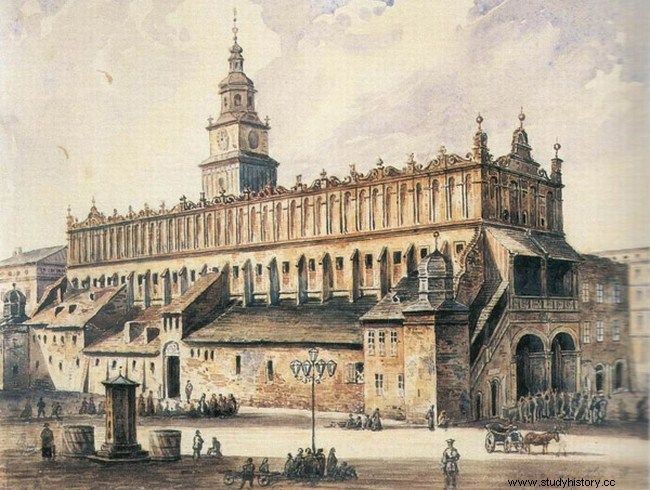
Krakow's Cloth Hall in a painting by A. Gryglewski from 1869. The building was one of the inspirations for the creators of the Palace of Culture and Science in Warsaw (source:public domain).
3. Dear Palace…
"Beijing" evoked extreme emotions in people from the very beginning. Similar to a rocket, it aroused fear and aesthetic disgust. However, nothing surprised the Palace staff more than letters addressed directly to the building.
Writings starting with the words Beloved Palace or Regards to the Palace Staff and the Citizen Director , contained a variety of content. From praise of the building itself to requests for employment, antiques sales offers or complaints about neighbors:
Help me, because my neighbor took my copper, and he and his old lady were throwing me salt and sugar into the cement. I don't have any money for a court, and I don't know how to defend myself. And all without what my sheep had eaten some grass from his garden. Help me and settle down Valentine.
The palace therefore became more than a symbol of communist power - for many citizens it was the seat of the Party and its emanation.
4. Dior in the house of debauchery
The Congress Hall in the Palace was the site of the greatest cultural events of post-war Warsaw. The most famous Polish and foreign artists performed on its stage, and from time to time it also hosted fashion shows - both by domestic and great foreign designers. In 1965, the Christian Dior Fashion House itself presented its winter collection here. It was the first event of this type in Poland.
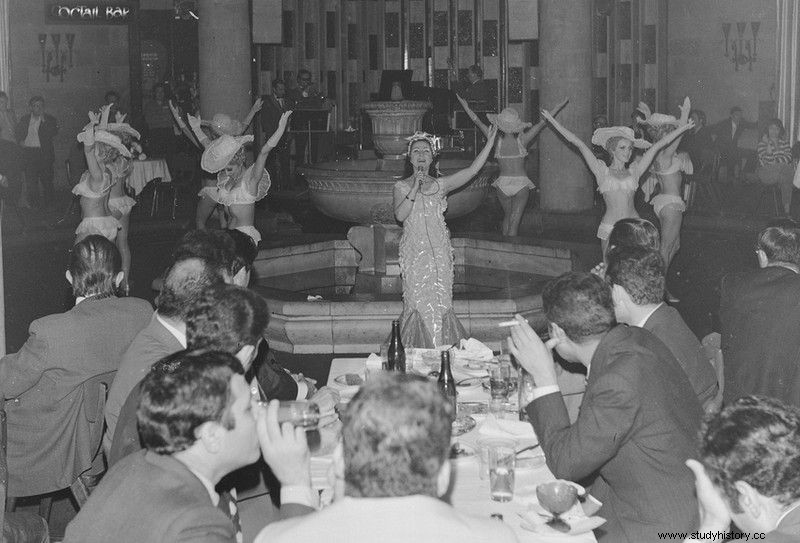
Is it just a dance or is it a striptease? The photo comes from the book “Pałac. Intimate Biography ”.
"Kongresowa" was also known for its no less popular revue performances, combining music and scantily clad dancers. With time, revues turned into strip shows. The resonance caused by some of the promiscuous performances can be found in the indignant letters: This is where the greatest filth-filth and disgrace takes place!
Nightlife also took place in the Trojka Restaurant, which was visited by high-ranking officials, often accompanied by prostitutes. The most frequent guests of the striptease were Soviet delegations coming to Warsaw even from the farthest regions of Siberia. However, no confirmation of this practice can be found in any of the official documents, except for bills with a special stamp "Palace of Culture and Science in Warsaw, Trojka Restaurant".

5. Łazienki carps for employees
On April 6, 1958, the employees of the Palace of Culture and Science were surprised by a new resolution of the Presidium of the National Council. According to her decision, quoted in the book by Hanna Szczubełek:
The Palace Board took over all the facilities of Łazienki Park into administration and use […] In the Hermitage, plants were grown for the Palace and their surplus was sold. The management also dealt with breeding carps and ornamental birds.
From then on the Palace employees spent their Saturday shifts weeding the beds in the Royal Łazienki. The investment turned out to be profitable:tulip seedlings and other ornamental plants were sold, and carp were sold on Christmas Eve. Even puppies of shepherd dogs used to protect the garden were traded.
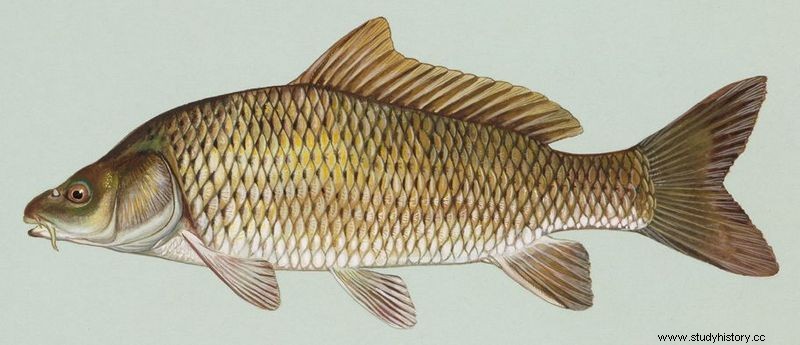
Will you buy a carp from an employee of the Palace of Culture and Science? (source:public domain)
The employees themselves also used the gifts of nature in Łazienki. This golden era for them, however, only lasted until 1964, when the park was attacked by vandals. The then director of the Palace was blamed for the damage. The Warsaw press also laughed at the beautiful sheepdogs, which were supposed to prevent this type of break-in.
6. Tunnel conspiracy theories
The palace has a total of 42 floors, none of them, however, touched the Polish imagination as much as the basement of the building. According to some they were supposed to be a nuclear shelter, according to others they were a maze of secret passages . Among the most interesting conspiracy theories to this day, there is a belief that there is a passage leading straight to the Party House, i.e. the seat of the Central Committee.
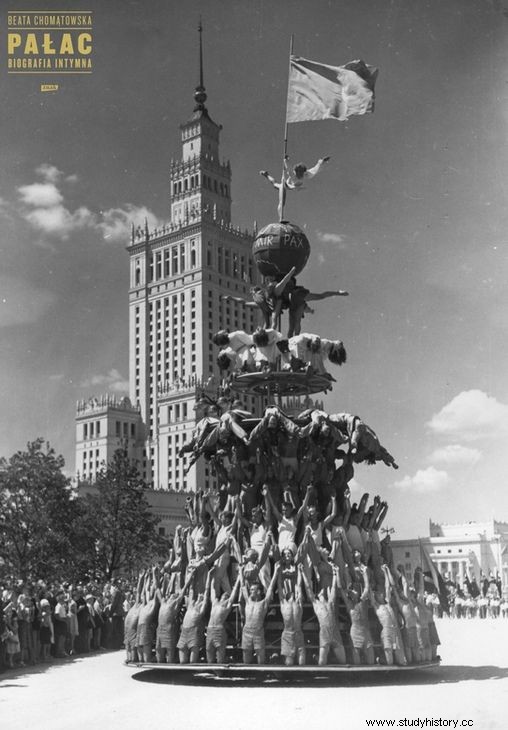
The opening of the Palace of Culture and Science was celebrated with such a cake. The photo comes from the book by Beata Chomątowska “Pałac. Intimate biography ”(SIW Znak 2015).
After the tragic gas explosion in the Rotunda of PKO, its causes were found in the alleged basement of the Palace. They were supposed to be a secret railway station, receiving trains bringing party leaders from other countries. The catastrophe was supposed to be the result of a terrorist attack on one of these trains.
